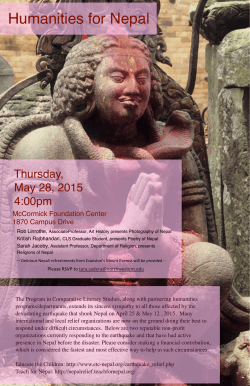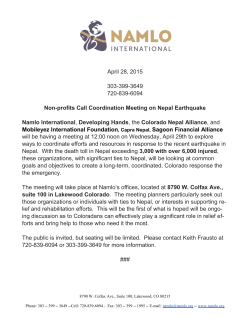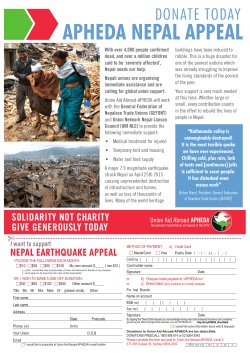
IUGS E-Bulletin #107
NEWS AT A GLANCE • • • • • • • • A Major Earthquake Hit Nepal on April 25: Deadliest Disaster in the Country’s History since 1934 News for the New IGGP Umbrella Call for Evaluators of IUCN Applications for World Heritage Sites (Deadline Sept. 15) IUGS New Affiliated Organization: Geological Association of Canada Heritage Stone Task Group at EGU General Assembly 2015 SCOSTEP–WDS Workshop on Global Data Activities for the Study of Solar–Terrestrial Variability, Tokyo (Sept. 28–30, 2015) International Conference on Geoethics, Prague and Pribram (Oct. 9–19, 2015) Polar Data Forum II 'International Collaboration for Advancing Polar Data Access and Preservation' Ontario (Oct. 27–29, 2015) A MAJOR EARTHQUAKE HIT NEPAL ON APRIL 25: DEADLIEST DISASTER IN THE COUNTRY’S HISTORY SINCE 1934 On April 25, 2015 a magnitude-7.8 (GFZ–GEOFON) earthquake struck Nepal, at the Himalayan mountain front. It was followed by strong aftershocks reaching a magnitude of 6.7 (USGS) during the following two days. The epicenter of this quake was 34 km southeast of Lamjung (Nepal) and its depth was shallow, around 19 km into the crust. Although predictable and to some extent foreseeable, this event hit the country hard. Earth scientists have long warned that Nepal was due for a major earthquake, which would be devastating due to its geological conditions, rugged landscape, rapid urbanization and non-earthquake proof building practices. The steep front of the Himalaya where Nepal is situated is particularly vulnerable because of its landslide potential, its historical, rural and artisanal constructions in a rough terrain. The aftermath of the April 25 earthquake and the following aftershocks has been an immeasurable loss of life and property damage. Some of the UNESCO World Heritage sites in the Kathmandu Valley and several hundred years–old buildings were destroyed. Earthquake-triggered avalanches on Mount Everest resulted in 19 casualties, the worst in the history of this idol for climbers and mountaineers, and in a large number of missing people. Our dynamic planet Earth forces us again to humbly accept our role as sojourners on its surface. The 2015 Nepal earthquake should remind all of us, particularly the government officials, policy-makers, city/town planners, and members of the societies, that we need a better understanding of the causes of these natural hazards and a more effective preparedness for them. Our professionalism in Geoscience education, field-based as well as experimental research and innovative studies have improved our understanding of the geodynamic processes behind earthquake occurrences. This knowledge should allow us to better assess the potential risks of natural hazards and to prepare efficient mitigation plans for their happenings. To maintain a sustainable world, in which human vulnerability can be reduced and the safety of the global society is increased, all of us bear the responsibility at a global scale to bridge the gap between the science and society and to increase public awareness and general education about natural hazards. Population increase, expanding human settlements in hazardous areas and increased life standards raise our vulnerability, facing a myriad of natural hazards. Since the geological processes, plate tectonic mechanisms and associated natural hazards shall not suddenly halt, an ever-expanding society shall have to adapt, to prepare and to be better educated about them. Thus socio-economic as well as political administrative sciences need to cooperate with Geosciences in order to prepare for, respond to, and mitigate natural hazards and their consequences. To this end, some necessary and logical steps towards a more holistic approach to natural hazards were discussed and taken by Geoscientists in Sendai most recently (April 2015), during the UN World Conference on Disaster Risk Reduction. The people of Nepal, although well adapted to the harsh physical conditions in their high-mountain environment, were struck by our beloved nature running one of its geological marvels, namely the mountain building, their endurance and love for their country shall help them rebuild it. However, in the face of this major catastrophic event, the nation of Nepal needs massive international disaster relief and rescue efforts now, and global financial and technical support in the long run to help reconstruct its fragile economy and infrastructure. On behalf of the geoscientists represented by the IUGS, I offer my deepest sympathy to Nepal and the people affected by this recent catastrophe. Communicated by IUGS President Roland Oberhänsli For more information on this event, we recommend the dedicated page by the IAEG. NEWS FOR THE NEW IGGP UMBRELLA On April 21, 2015, the Executive Board of UNESCO has agreed to ask the UNESCO General Conference to endorse the proposed reform of IGCP into the new IGGP and the creation of UNESCO Global Geoparks (see IUGS e-bulletin #105). The General Conference will meet in November this year. And, as IUGS was informed by the Head of the Geoscience Office at UNESCO in Paris, Patrick McKeever, no changes were made to any of the documents—statutes and guidelines on which the community has worked so intensely during last February’s meeting in Paris! IUGS President Roland Oberhänsli would like to thank all people involved in this challenge and wish us, the geo-community, success in November. CALL FOR EVALUATORS OF IUCN APPLICATIONS FOR WORLD HERITAGE SITES (DEADLINE SEPT. 18) Being responsible for the evaluation of the nominated sites under World Heritage Convention Criterion (viii) for the outstanding geologic values, IUGS is calling for interested partners/evaluators, to review the geological interest of new properties that the International Union for Conservation of Nature (IUCN) will need to evaluate for the 40th Session of the World Heritage (WH) Committee in June 2016. These properties are marked with an asterik below. IUGS needs find about 8–10 IUGS partners per nominated property who could provide a desktop review. If you or your colleagues are interested in providing a review of a property that does not fall under criterion (viii), this might be acceptable too. Please send your expression of interest with indication of the desired site to be evaluated to Marko Komac (marko.komac@geo-zs.si). IUGS thanks you for your cooperation. The final deadline for evaluation is September 18. Below is the full list of the new properties that will be evaluated for the 40th Session of the World Heritage Committee in June 2016, and further on is the summary justifications for Criterion (viii) for three of the nominated properties as delivered by the IUCN. Four (4) sites (in asterisk) have been nominated under World Heritage Convention Criterion (viii) for outstanding geologic values: “WH Convention Criterion (viii): be outstanding examples representing major stages of earth’s history, including the record of life, significant on-going geological processes in the development of landforms, or significant geomorphic or physiographic features.” If an expert is interested in providing a review of a property, which is not nominated under (viii), this might be acceptable too. Natural Properties Hubei Shennongjia (PR China) * Lut Desert (IR Iran) * Western Tien-Shan (Kazakhstan, Kyrgyzstan, Uzbekistan) Mountain Ecosystems of Koytendag (Turkmenistan) * Mistaken Point (Canada) Western Caucasus [Significant boundary modification] (Russian Federation) Virgin Komi Forests [Significant boundary modification] (Russian Federation) * Archipiélago de Revillagigedo (Mexico) Mixed Properties (natural and cultural values) Massif de l’Ennedi: paysage naturel et culturel (Chad) (nomination dossier in French only) The Ahwar of Southern Iraq: refuge of biodiversity and the relict landscape of the Mesopotamian Cities (Iraq) Khangchendzonga National Park (India) Pimachiowin Aki (Canada) And here is a Summary justification for criterion (viii) for each of the four nominated property: Lut Desert (IR Iran) ''In addition to wind erosion as a continuous process in forming the landforms of arid areas, the water plays an exceptional role in development of geomorphic landforms of Lut Desert. The braided courses of Shur River creating wandering small linear channels on the area prepared good conditions for wind activity and development of kaluts (yardangs). On the other hand, the severe northwest-southeast winds, which are dominant on the o o o o Ennedi Massif (Chad) (nomination dossier in French only) The Ahwar of Southern Iraq (Iraq) Khangchendzonga National Park (India) Pimachiowin Aki (Canada) • Natural properties ○ Mixed (natural and cultural) properties Below are summary justifications for Criterion (viii) for three of the nominated properties, as delivered by the IUCN. Lut Desert (IR Iran) region duringtolong of years, “In addition windperiod erosion as a facilitate the process of yardang continuous process in forming the development. Nevertheless, the landforms of arid areas, the water evolutionan of exceptional the yardangsrole of the plays in region is also dependent upon the development of geomorphic fine grained sediments in landforms of Lut Desert. deposited The braided a fluvial lake ice age in Lut courses of related Shur to River creating Plain. Indeed, the history of wandering small linear channels the on geological evolutiongood of Lut Desert the area prepared conditions represents when the for wind activitythat and development of mountainous kaluts (yardangs). glaciers On the other were hand, Yardangs of the Lut Desert dominant on high latitude areas, (source: Source: NASA’s GES DISC) DISC the severe northwest-southeast some lakes in this winds, whichwere arecreated dominant on part the of the world to receiving were of a place for region duringdue long period ofhigher years,moisture. facilitateThe thelakes process yardang accumulation Nevertheless, of runoffs fromthe the surrounding The geologic development. evolution of thedrainage yardangsbasins. of the region is also and geomorphic process of Lut Desert inisa fluvial indicative of the dependent upon theevolution fine grained sediments deposited lake related transportation of Plain. the sediments fromhistory yardangs the southern and eastern to ice age in Lut Indeed, the of theto geological evolution of Lut receiving higher moisture. The lakes were a place for accumulation ofon runoffs part of represents the region.that Thiswhen accelerated the evolution process Rig-e Yallan. In Desert the mountainous glaciers wereofdominant high from the surrounding drainage basins. The geologic and geomorphic evolution other words, during the evolution of the landforms in the region, the wind latitude areas, some lakes were created in this part of the world due to process of Lut is indicative of corridors the transportation of the sediments transported theDesert sediments from the among yardangs and fromfrom the yardangs to the southern and eastern part of the region. This accelerated the surface of alluvial fans and endorheic basins to the south and east. This evolution process of Rig-e words,sand during the evolution of the prepared the conditions for Yallan. creationInofother the highest dunes of the world.'' landforms in the region, the wind transported the sediments from the corridors among yardangs and from the surface of alluvial fans and endorheic basins to Western Tien-Shan (Kazakhstan, Kyrgyzstan, Uzbekistan) the south and east. This prepared the conditions for creation of the highest The description will be sent by IUCN after the express of interest by experts. sand dunes of the world.” Mistaken Point (Canada) Mistaken Point (Canada) ''Mistaken Point is nominated as the “Mistaken Point is nominated as the site that best illustrates the earliest site that best illustrates the earliest stages in the emergence of stages the emergence of biological incomplexity on our planet, biological complexity on our planet, ''when life got big'', 580 million years “when life gotthe big,”Ediacaran 580 millionPeriod. years ago during ago during the Ediacaran Period. The many thousands of impressions The many thousands of impressions of soft-bodied, centimetreto meterof soft-bodied, centimeterto meterscale creatures preserved at scale preserved at Mistakencreatures Point document the oldest Edicarian Edicarian rangeomorphs rangeomorphs and and Mistaken Point document the oldest large and biologically complex charniodiscus fossils at Mistaken Point charniodiscus fossils at Mistaken Point large and biologically complex creatures known anywhere and are © Royal (© Royal Ontario Ontario Museum Museum) creatures known anywhere and the are generally regarded as including generally regarded as including thetheearliest (stem-group) ancestors of the earliest (stem-group) ancestors of animals. The nominated property of animals. The nominated property of Mistaken Point also provides key Mistaken Point also provides key information about the ecology of these information about and the ecology ofearly thesecolonization ancestral animals and about the early ancestral animals about the of the deep-sea floor.'' colonization of the deep-sea floor.” Archipiélago de Revillagigedo; Mexico Archipiélago de Revillagigedo (Mexico) ''The geographically isolated oceanic islands of the tropical Archipielago de “The geographically isolated oceanic islands of the tropical Archipiélago de Revillagigedo and surrounding waters are among the most unique, well preserved and beautiful ecosystems, landscapes scale creatures preserved at Edicarian rangeomorphs and Mistaken Point document the oldest charniodiscus fossils at Mistaken Point large and biologically complex (© Royal Ontario Museum) creatures known anywhere and are generally regarded as including the earliest (stem-group) ancestors of the animals. The nominated property of Mistaken Point also provides key information about the ecology of these ancestral animals and about the early colonization of the deep-sea floor.” Archipiélago de Revillagigedo (Mexico) Revillagigedo and surrounding “The geographically isolated waters areislands among the oceanic of most the unique, tropical well preserved and beautiful Archipiélago de Revillagigedo and ecosystems, waters landscapes surrounding are among and the seascapes on Earth. Off Mexico's most unique, well preserved and mainland ecosystems, and well inside the beautiful landscapes Eastern Pacific Ocean, groupOff of and seascapes on this Earth. four volcanic islands (Socorro, Mexico’s mainland and well inside Clarion, San Benedicto and Roca the Eastern Pacific Ocean, this Partida) have a formation group of four volcanic islands— Roca Partida Island island associated with the Socorro, Clarión, Sanboundaries Benedicto and and (© David Valencia) activities of the Pacific,aRivera and Roca Partida—have formation Cocos tectonic sharply emerging fromofthe plain onand theCocos deep associated with plates, the boundaries and activities the abyssal Pacific, Rivera ocean floor at 4,000 m below sea surface. The island arch composing the tectonic plates, sharply emerging from the abyssal plain on the deep ocean archipelago is m partbelow of a sea submarine range, four islands floor at 4,000 surface. mountain The island archthe composing the representing volcanoes' peaks that rise above sea level. The highest altitude archipelago is part of a submarine mountain range, the four islands is the peak of Cerro Evermann's volcano Isla The Socorro at 1,050 m representing volcanoes’ peaks thatactive rise above seaonlevel. highest altitude above sea level. On top of its already singular geological history and location, Archipielago de Revillagigedo represents an exceptional convergence of two very different and large marine biogeographic regions: the Northeastern Pacific with the highly productive temperate waters of the California Current moving southward, and the Tropical Eastern Pacific. More particularly, the islands of Archipielago de Revillagigedo lay at a sui generis junction where the California and Equatorial currents mix, generating a transition zone between three provinces: the Gulf of California and Lower Pacific Baja California, the Panamic (southward), and Archipielago de Revillagigedo as a oceanic island province on its own. Because of this, the archipelago's marine and terrestrial ecosystems add to wide-scale connectivity within the Tropical Pacific Ocean. Influenced by the Northern Equatorial Current that transports tropical water from west to east, these islands are also recognized as stepping-stones in the migration of marine species from the Western and the Eastern Pacific.'' IUGS NEW AFFILIATED ORGANIZATION: GEOLOGICAL ASSOCIATION OF CANADA On April 20, 2015, IUGS Council agreed to the IUGS Executive Committee’s decision to grant the status of Affiliated Organization to the Geological Association of Canada (GAC). Detailed information about the GAC is available on its official website. HERITAGE STONE TASK GROUP AT EGU GENERAL ASSEMBLY 2015 Lola Pereira, Björn Schouenbor, Sabina Kramar, and Barry Cooper, all from the Heritage Stone Task Group (HSTG) board, convened a HSTG session on Natural Stone Research and Heritage Stone designation at the EGU General Assembly, Vienna (Austria), on April 15, 2015. Twenty-nine oral and poster contributions were presented at this session, i.e. ten more than last year’s session. Contributions from fourteen countries were presented, with possible examples of Global Heritage Stone Resources. Some of them were related more to technical aspects and analytical issues. The audience was larger this year as well and more enthusiastic in knowing the different aspects of HSTG and the presented stones. Some of the contributions will be published in special issues. More on the HSTG session program here. On the following day, the group met in a Splinter Meeting, where different issues of the Task Group were discussed, as well as future activities and diffusion and publication of the outcomes. After the meeting, Beatrix Moshammer, member of the HSTG from Austria, led a two-hour tour around the city to show the built environment and the natural stones used in the buildings. SCOSTEP–WDS WORKSHOP ON GLOBAL DATA ACTIVITIES FOR THE STUDY OF SOLAR–TERRESTRIAL VARIABILITY, TOKYO (SEPT. 28–30, 2015) The SCOSTEP–WDS workshop on “Global Data Activities for the Study of SolarTerrestrial Variability” will be held at the National Institute of Information and Communications Technology in Tokyo, Japan, on September 28–30, 2015. The principal objective of the workshop is to stimulate interaction among data providers, data scientists, and the data-oriented researchers participating in the Scientific Committee on Solar–Terrestrial Physics (SCOSTEP), an interdisciplinary body of ICSU promoting a series of international research programs on solar–terrestrial connections. SCOSTEP's current program on “Variability of the Sun and Its Terrestrial Impact” (VarSITI) will strive for international collaboration in data analysis, modeling, and theory to understand how the solar variability affects the Earth’s environment in a vast range of time scale, from seconds to billions of years. Longterm preservation and provision of quality-assessed data and information are common objectives of SCOSTEP and WDS for the VarSITI programme, as well as development of advanced data systems to enable scientists to perform multidisciplinary data-analysis. This workshop will be a remarkable opportunity to initiate close collaboration between SCOSTEP and WDS to promote our dataoriented activities by introducing outcomes from information technology. Data analysis of selected solar-terrestrial events will be an important component of the workshop also, in order to not only develop the study of solar-terrestrial variability but also establish a mutual feedback loop between 'data users' and data providers. Abstract submission, registration, and hotel reservation are now open for the Workshop. More on the workshop website. Contact: contact-scostep-wds@icsu-wds.org INTERNATIONAL CONFERENCE ON GEOETHICS, PRAGUE AND PRIBRAM (OCT. 9–19, 2015) The International Conference on Geoethics, organized by the AGID Working Group for Geoethics, will be held in Prague and Pribram (Czech Republic) in three segments: Oct. 9–11 in Prague arrival; sightseeing; "warming up": free discussions, possible workshop; Oct. 12–16 in Pribram lectures; short presentations; discussions; geo-art; excursions; Oct. 16–19 in Prague lectures; short presentations; discussion; establishment of committees and groups for special purposes; editorial group for final documents. The Conference is expected to take objective standpoints to all main present neuralgic points of ethics and geoethics in the world in any liaison with the Earth Sciences and with the needed improvement of ethical climate in Europe and in the world. Various new concepts outside main streams should be open for a discussion where constructive alternative solutions may help to accelerate the needed progress of the science, and improve short and long term predictability of natural disasters in the present period of extreme conditions beyond any memory of the human kind (for optimizing needed prevention measures). Any immediate contact with organizers (nemec.geo@seznam.cz; dolezalova@diamo.cz) may help to form a more tailor-made final program of all segments. POLAR DATA FORUM II 'INTERNATIONAL COLLABORATION FOR ADVANCING POLAR DATA ACCESS AND PRESERVATION' ONTARIO (OCT. 27–29, 2015) The Polar Data Forum II will build on successes of the first International Polar Data Forum in October 2013 in Tokyo, Japan that—alongside other international and national meetings—identified priority themes and key challenges in the domain of polar data management (Polar Data Forum Communiqué). The second Polar Data Forum will further refine these themes and priorities, and will accelerate progress by establishing clear actions to address the target issues, including meeting the needs of society and science through promotion of open data and effective data stewardship, establishing sharing and interoperability of data at a variety of levels, developing trusted data management systems, and ensuring long-term data preservation. The Forum will be held in conjunction with the scheduled annual meetings of both the Arctic Data Committee of the International Arctic Science Committee and Sustaining Arctic Observing Networks and the Standing Committee on Antarctic Data Management of the Scientific Committee on Antarctic Research (SCAR), effectively creating a Polar Data Week. First Circular is available here. More information on the forum website. NOTES • If you require notices, information on publications, etc. to be considered for inclusion in forthcoming IUGS e-bulletins, please mailto:Amaury@geo.uni-potsdam.de • Please check the IUGS Calendar of Events for upcoming scientific meetings this coming month. If you require information on international conferences, meetings, etc. to be considered for inclusion in this Calendar please mailto:pbobrows@NRCan.gc.ca. • To be added to or removed from the IUGS e-bulletin distribution list, please mailto:iugs.beijing@gmail.com. Prepared by: Amaury Pourteau Post-doctoral researcher Institute of Earth and Environmental Science Potsdam University — Germany +49 331 977 5846 amaury@geo.uni-potsdam.de http://www.iugs.org
© Copyright 2025













